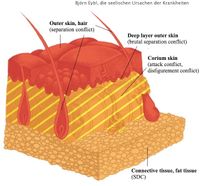Outer skin (epidermis)
Also see the general programs of the ectoderm, vitiligo, hair loss, corium skin, connective tissue and periosteum.
Sensitivity follows the outer skin pattern.
Whether it involves the left or right side of the body depends on the biological laterality of the person.
Theme
Separation conflict, not being able or allowed to have contact.
The location on the body also depends on the details of the content of the conflict, see also the skeleton on new mesoderm at the bottom of the page.
Front and back of the body: the belly, chest and inside of arms have to do with "not being able to have contact" (wanting to hug someone but can't) and the back and elbows with "not wanting to have contact" (wanting to push someone away from you but not able to).
In nature, being separated from the herd can result in death.
CA phase
Local decrease in epidermal thickness, numbness (reduction in skin sensitivity) and temporary short-term memory loss.
Symptoms
Rough, dry, pale (poor blood circulation), cold, sometimes somewhat scaly skin.
In a very prolonged process, the sensitivity of the skin can disappear (almost) completely (neurodermatitis) and the one from whom one is separated can be completely forgotten (see also the constellation below).
In animals, this happens very quickly: after a few hours to a few days, they no longer recognize their offspring as their child.
Biological purpose
The numbness and amnesia cause the person who is missed to be forgotten for the time being. One can therefore move on with life.
In animals, this ís the solution.
PCL phase
Rebuilding of the epidermis, the person can make contact and be caressed again.
Symptoms
Skin rash, neurodermatitis (can thus be diagnosed in both the Ca and PCL phases).
Short-term memory loss continues in this phase. Warm, red skin, burning sensation, painful itching, swelling.
In syndrome, swelling can be severe and very painful.
Itching: the skin "screams" to be caressed now it can be caressed again. Itching can be especially severe in the PCL-B.
Measles, rubella, scarlet fever, chicken pox, herpes, cold sores, etc. are all recovery phases of separation conflicts.
EC
Cold sweats, chills, pain, absence or fainting.
The short-term memory loss in the Ca and PCL phases and the absence in the crisis may cause the person or event to be forgotten.
Psoriasis: combination of a CA phase and a PCL phase of two separation conflicts at the same time, both hanging and alternating. White, scaly patches (Ca phase) and red, itchy patches (PCL phase) overlap --> scales on red skin.
Contact allergies: reactions to tracks and traces. For example, the sun, metal and wool give sun allergy, metal allergy, wool allergy, respectively. Something shocking happened when the sun was shining, someone was wearing a metal ornament or a woolen sweater.
Hanging healing: chronic or regularly recurring skin rashes, eczema.
Pending PCL-B: warts, magpie eyes, etc.
Constellation: frequent or persistent short-term memory loss, forgetfulness, dementia.

